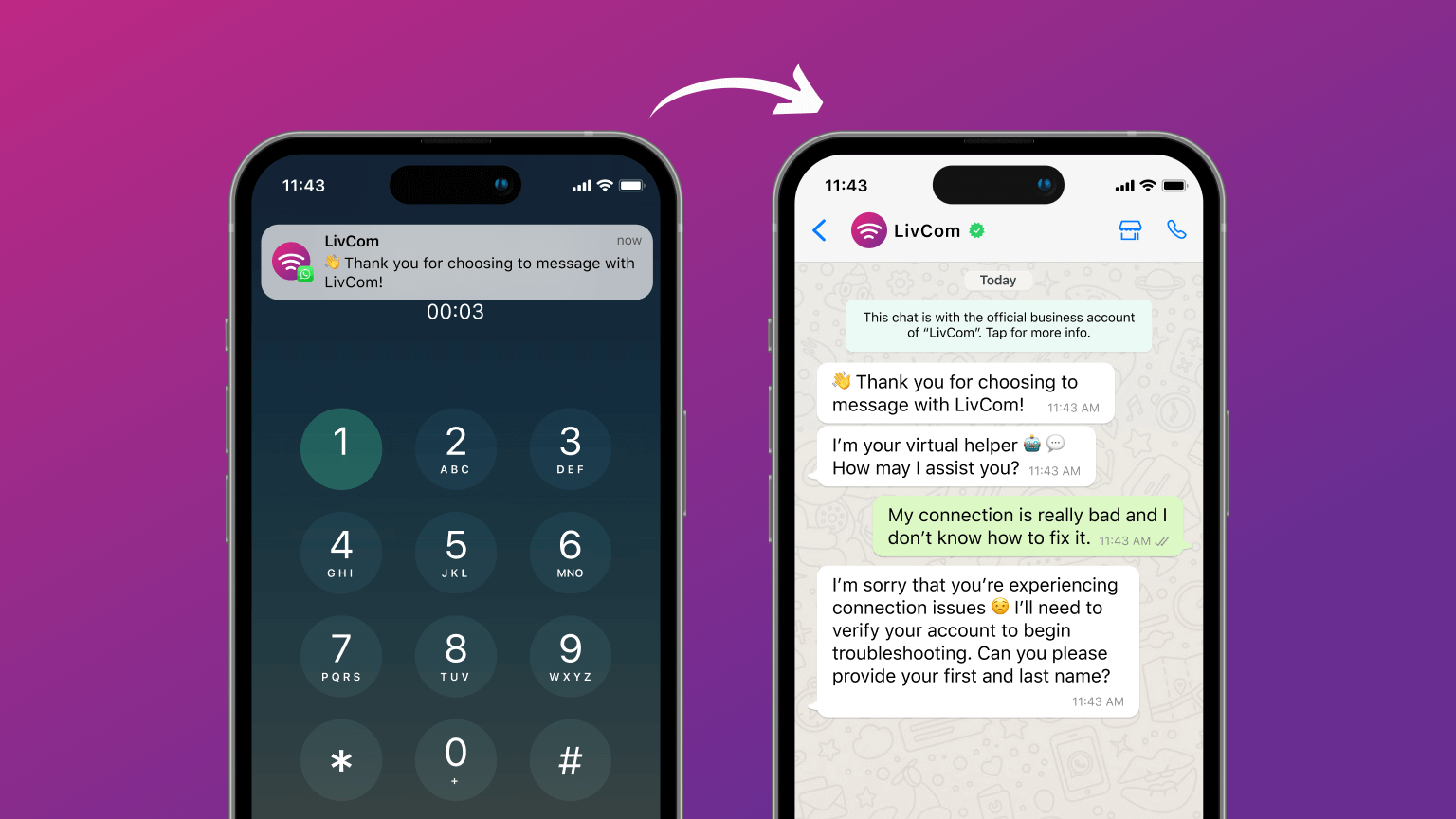article
Transforming call reduction with the power of conversation shifting
Unlocking a seamless customer experience for incoming calls
June 24, 2024 • 5 minutes

In today’s business landscape, where customers demand seamless interactions across multiple channels, relying solely on traditional phone calls can be limiting. High call volumes inundating contact centers often leads to prolonged wait times and frustrated customers. However, there’s a transformative solution on the horizon: conversation shifting. This innovative approach to call reduction not only streamlines customer interactions but also boosts satisfaction levels and slashes contact center costs. Let’s delve into why conversation shifting might be the missing piece in your customer engagement strategy.
What is conversation shifting?
Picture this: a customer starts a phone call seeking assistance. Instead of enduring lengthy hold times or navigating complex IVR menus, they’re presented with an alternative — seamlessly shifting the conversation to the messaging platform of their choice. Businesses can make this transition effortless, allowing customers to continue their conversation where they left off, but now via messaging. Conversation shifting isn’t just a one-off solution; it’s a vital component of omnichannel support. Customers can seamlessly transition between voice and messaging without having to start the conversation over, ensuring consistency and efficiency throughout their journey.
What is the difference between conversation shifting and call reduction?
Conversation shifting represents a significant evolution from traditionally effective call reduction strategies. While call reduction primarily focuses on minimizing call volume costs by encouraging customers to self-serve or opt for alternative channels, conversation shifting takes a broader approach. Yes, it still addresses call center cost efficiency, but it goes beyond that. It’s about crafting a seamless and interconnected customer experience across voice and messaging platforms. It’s not solely about saving money; it’s about boosting customer satisfaction and fostering stronger connections.
What is the difference between conversation shifting and IVR deflection?
While conversation shifting is indeed a component of IVR deflection, it represents a more advanced and refined approach to customer engagement. Setting up standard IVR deflection isn’t easy and can take months to deploy within your contact center due to complicated integrations. Conversation shifting with LivePerson can be built and deployed using a voice AI deflection bot in as little as two weeks.
How does conversation shifting work?
Conversation shifting operates on a simple yet powerful premise: providing customers with the flexibility to seamlessly transition from voice to messaging channels, all while maintaining continuity in their interactions. Here’s how it works:
Customers are presented with an option to escape the IVR queue by simply pressing a designated number, typically “1.” This action initiates the process of transferring the conversation to the messaging channel of their choice. Customers experience a seamless and personalized experience throughout the conversation journey — regardless of channel. This continuity not only saves customers from the frustration of starting over on a new channel but also fosters a sense of rapport and trust.
Why should brands care about this improved call reduction strategy?
The value proposition of conversation shifting extends far beyond operational efficiency — it’s about meeting and exceeding customer expectations while driving tangible business outcomes. Here’s why brands should prioritize conversation shifting:
- Significant cost savings and fast ROI: By embracing conversation shifting and directing customer calls into digital channels, brands can realize substantial cost savings, with potential reductions in cost per call exceeding 40%. Implementing conversation shifting can yield rapid returns on investment, with contact center costs decreasing within a matter of weeks rather than months.
- Fast implementation and time to value: Unlike traditional voice automation and call routing IVR solutions, which often entail lengthy and complex integration processes, conversation shifting offers a streamlined path to deployment. With LivePerson’s intuitive chatbot builder, brands can swiftly build and deploy voice deflection bots, accelerating time to value and minimizing disruption to operations.
- Meeting customer expectations: Today’s customers expect seamless and integrated experiences across phone and messaging channels. By embracing conversation shifting, brands can meet these evolving expectations and differentiate themselves in the market. Studies show that 8 out of 10 consumers are more likely to patronize businesses that bridge the gap between phone and messaging interactions, underscoring the importance of aligning with customer preferences and behaviors.
Benefits of conversation shifting for businesses
Evolving call reduction strategies with conversation shifting offers several key benefits for businesses, from streamlining operations to creating an exceptional customer experience, and driving overall growth:
- Reduce voice channel expenditures: By automating routine support calls, conversation shifting reduces the workload on live contact center agents, allowing them to focus on handling complex issues. This automation not only improves efficiency but also reduces the cost per call, leading to significant savings for the business.
- Improve customer omnichannel experiences: Conversation shifting creates a more natural IVR experience, enabling quick and accurate resolution of customer inquiries across channels. This seamless transition between voice and digital platforms enhances the overall customer journey, resulting in faster issue resolution times, improved efficiency, and higher customer satisfaction (CSAT) scores.
- Boost agent retention in the contact center: By reducing the burden on live voice agents and revolutionizing operations, conversation shifting helps build higher job satisfaction and boost agent retention in the contact center. By driving customers to messaging platforms, agents can manage conversations with more ease, personalization, and efficiency — keeping agents engaged, happy, and fulfilled in their roles.
It’s time to bring voice into the digital age
Ready to revolutionize your customer engagement strategy? Discover the value of conversation shifting for your business today. Learn more about LivePerson’s voice to digital omnichannel solutions and unlock the power of enhanced customer experiences and improved operational efficiency. Download the playbook to go beyond call reduction strategies and explore how bringing voice into the digital ecosystem can transform your contact center and drive business success.


